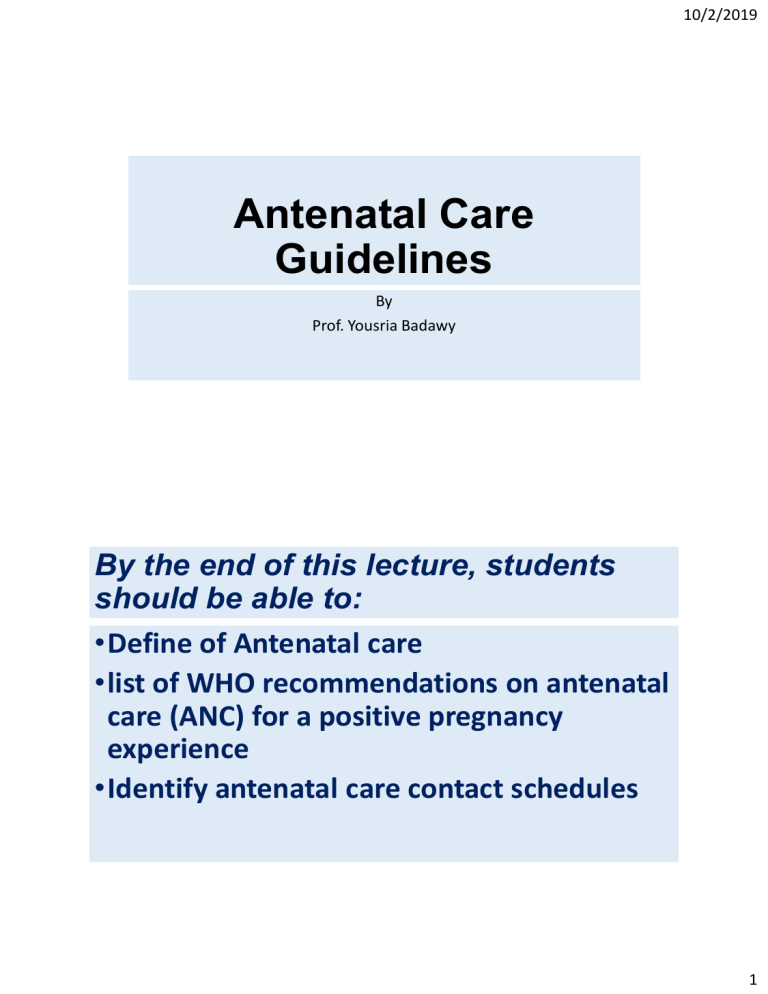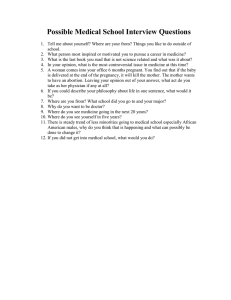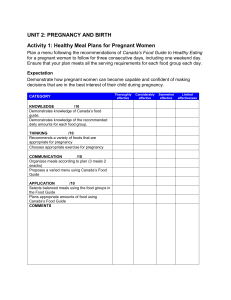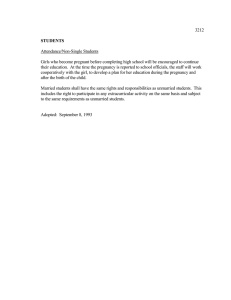
10/2/2019
Antenatal Care
Guidelines
By
Prof. Yousria Badawy
By the end of this lecture, students
should be able to:
•Define of Antenatal care
•list of WHO recommendations on antenatal
care (ANC) for a positive pregnancy
experience
•Identify antenatal care contact schedules
1
10/2/2019
Definition of Antenatal care
Antenatal care (ANC) can be defined as the care provided by
skilled health-care professionals to pregnant women in
order to ensure the best health conditions for both mother
and baby during pregnancy. The components of ANC
include:
1. risk identification;
2. prevention and management of pregnancy-related or
concurrent diseases; and
3. health education and health promotion.
AIMS OF ANTENATAL CARE
• Monitoring the progress of pregnancy with
minimum interference
• Guidance to the expectant mother
• Early detection of any deviation from
normal
•Preparation of the mother for labour &
delivery
2
10/2/2019
Summary list of recommendations on antenatal care
(ANC) for a positive pregnancy experience
1- Nutritional interventions
2- Maternal and fetal assessment
3- Preventive measures
4- Interventions for common
physiological symptoms
A: Nutritional interventions
1- Dietary interventions:
• Counselling about healthy eating and keeping
physically active during pregnancy is recommended
for pregnant women to stay healthy and to prevent
excessive weight gain during pregnancy.
• In undernourished populations, nutrition education
on increasing daily energy and protein intake is
recommended for pregnant women to reduce the risk
of low-birth-weight neonates.
3
10/2/2019
2- Iron and folic acid supplements:
Daily oral iron and folic acid supplementation
with 30 mg to 60 mg of elemental iron (The
equivalent of 60 mg of elemental iron is 300 mg
of ferrous sulfate , 180 mg of ferrous fumarate or
500 mg of ferrous gluconate) and 0.4 mg of folic
acid is recommended for pregnant women to
prevent neural tube defect, maternal anemia,
puerperal sepsis, low birth weight, and preterm
birth.
3- Calcium supplements:
In populations with low dietary calcium intake, daily
calcium supplementation (1.5–2.0 g oral elemental
calcium) is recommended for pregnant women to
reduce the risk of pre-eclampsia
4- Vitamin A supplements:
Vitamin A supplementation is only recommended for
pregnant women in areas where vitamin A deficiency
is a severe public health problem, to prevent night
blindness. Supplemental doses exceeding 5000IU/day
should be avoided .
4
10/2/2019
5- Not recommended:
• Zinc supplements
• Multiple micronutrient supplements
• Vitamin B6 (pyridoxine) supplements
• Vitamin E and C supplements
• Vitamin D supplements
6- Restricting caffeine intake : For pregnant women with high daily
caffeine intake (more than 300 mg per day), lowering daily caffeine
intake during pregnancy is recommended to reduce the risk of
pregnancy loss and low-birth-weight neonates (This includes any
product, beverage or food containing caffeine (i.e. coffee, tea, cola-type
soft drinks, caffeinated energy drinks, chocolate, caffeine tablets).
B. Maternal and fetal assessment
Maternal assessment:
1- Anemia: Full blood count testing is the
recommended method for diagnosing anemia in
pregnancy. In settings where full blood count
testing is not available, on-site haemoglobin
testing with a haemoglobinometer is
recommended over the use of the haemoglobin
colour scale as the method for diagnosing anemia
in pregnancy.
5
10/2/2019
A hemoglobinometer is a medical measuring device
of hemoglobin blood concentration. It can operate by
spectrophotometric measurement of hemoglobin
concentration.
Portable hemoglobinometers
provide easy and convenient
measurement of hematological
variables, especially in areas
where no clinic laboratories
are available.
2- Urine tests: urine is checked for several things,
including protein (It may be a sign of preeclampsia.).
Asymptomatic bacteriuria (ASB): Midstream
urine culture is the recommended method for
diagnosing asymptomatic bacteriuria (ASB) in
pregnancy. In settings where urine culture is not
available, on-site midstream urine Gram staining
is recommended over the use of dipstick tests as
the method for diagnosing ASB in pregnancy.
6
10/2/2019
3- Intimate partner violence : Clinical
enquiry about the possibility of intimate
partner violence (IPV) should be strongly
considered at antenatal care visits when
assessing conditions that may be caused or
complicated by IPV in order to improve
clinical diagnosis and subsequent care,
where there is the capacity to provide a
supportive response (including referral
where appropriate).
4- Gestational diabetes mellitus (GDM): Hyperglycaemia first
detected at any time during pregnancy should be classified as
either gestational diabetes mellitus (GDM) or diabetes
mellitus in pregnancy.
A woman may be at higher risk of developing diabetes in
pregnancy (gestational diabetes) if she :
• is overweight
• has had diabetes in pregnancy before
• has had a baby weighing 4.5kg (9.9lb) or more before
• has a close relative with diabetes
• is of southeast Asian, black Caribbean or Middle Eastern
origin
7
10/2/2019
5- Tobacco use: Health-care providers should ask
all pregnant women about their tobacco use (past
and present) and exposure to second-hand
smoke as early as possible in the pregnancy and
at every antenatal care visit.
6- Substance use: Health-care providers should
ask all pregnant women about their use of alcohol
and other substances (past and present) as early
as possible in the pregnancy and at every
antenatal care visit.
7- Human immunodeficiency virus (HIV), syphilis and
hepatitis B:
In high-prevalence settings, provider-initiated testing
and counselling for HIV should be considered a routine
component of the package of care for pregnant women
in all antenatal care settings.
8- Tuberculosis (TB): In settings where the tuberculosis
(TB) prevalence in the general population is
100/100 000 population or higher, systematic screening
for active TB should be considered for pregnant women
as part of antenatal care.
8
10/2/2019
Important measures done in ANC:
•Weight and height checks in pregnancy
•Blood pressure tests in pregnancy:
blood pressure will be checked at every
antenatal visit. A rise in blood pressure later
in pregnancy could be a sign of preeclampsia.
•Blood group and rhesus status
Fetal assessment
Ultrasound scan: One ultrasound scan before 24
weeks of gestation (early ultrasound) is
recommended for pregnant women to:
• estimate gestational age,
•improve detection of fetal anomalies
•detection multiple pregnancies,
•reduce induction of labour for post-term
pregnancy,
9
10/2/2019
C: Preventive measures
1- Antibiotics for asymptomatic bacteriuria (ASB) : A
seven-day antibiotic regimen is recommended for all
pregnant women with asymptomatic bacteriuria (ASB)
to prevent persistent bacteriuria, preterm birth and
Puerperal sepsis
2- Tetanus toxoid vaccination : Tetanus toxoid
vaccination is recommended for all pregnant women,
depending on previous tetanus vaccination exposure,
to prevent neonatal mortality from tetanus.
D. Interventions for common
physiological symptoms
1- Nausea and vomiting : Ginger, chamomile, vitamin
B6 and/or acupuncture are recommended for the relief
of nausea in early pregnancy, based on a woman’s
preferences and available options.
2- Heartburn : Advice on diet and lifestyle is
recommended to prevent and relieve heartburn in
pregnancy. Antacid preparations can be offered to
women with troublesome symptoms that are not
relieved by lifestyle modification.
10
10/2/2019
3- Leg cramps : Magnesium, calcium or nonpharmacological treatment options can be used
for the relief of leg cramps in pregnancy, based on
a woman’s preferences and available options.
4- Low back and pelvic pain : Regular exercise
throughout pregnancy is recommended to
prevent low back and pelvic pain. There are a
number of different treatment options that can
be used, such as physiotherapy, support belts.
5- Constipation: Wheat bran or other fiber
supplements can be used to relieve
constipation in pregnancy if the condition
fails to respond to dietary modification.
6- Varicose veins and oedema : Nonpharmacological options, such as
compression stockings, leg elevation and
water immersion, can be used for the
management of varicose veins and edema in
pregnancy.
11
10/2/2019
Antenatal care contact schedules :
Antenatal care models with a
minimum of eight contacts are
recommended to reduce
perinatal mortality and improve
women’s experience of care.
12
10/2/2019
• References:
• South-Paul J, Matheny S Lewis E. Current diagnosis and treatment in
Family medicine. 4th ed. Mc Grew Hill Lange 2015. ISBN-13: 9780071827454; ISBN-10: 0071827455
• Douglas G, Nicol F, Robertson C. Macleod's Clinical Examination, 12th
Edition ChurchilLivingstone | Elsevier © 2009, Elsevier Limited. Al rights
reserved.
• ADDITIONAL REFERENCES:
• American Family Physician Journal.
• http://www.aafp.org/afp.xml
13







